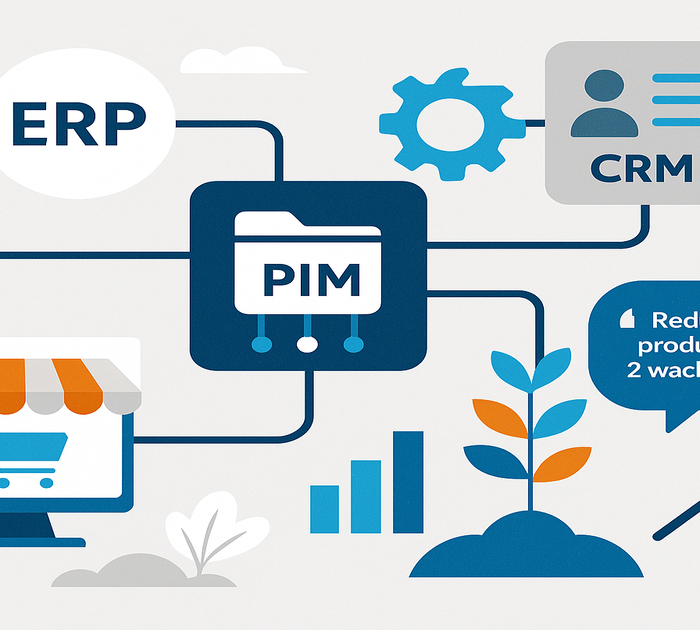New product introductions (NPIs) shouldn’t feel like a sprint through wet concrete. Yet for many manufacturing teams, the “simple” act of launching a SKU turns into a maze of missing attributes, last-minute image edits, and marketplace rejections. The fix isn’t more heroics; it’s content operations—a repeatable, cross-functional workflow that moves products from engineering truth to channel-ready stories. Here’s a human-friendly playbook your team can run this quarter.
Step 1: Align on outcomes (before you touch a field)
Start by stating the outcome in one sentence: “Publish the new line to dealers, Amazon, and our web store within seven business days of engineering release, at <1% listing error.” Because the destination is clear, every decision that follows is easier. Identify the top two channels that drive revenue, and time-box your first release to those. You can always add more later.
Step 2: Build the attribute bill of materials (ABOM)
Think of attributes as your content BOM. List the must-have fields for each channel—dimensions, materials, certifications, bullets, SEO title, and compliance language—along with who owns them. Then lock two rules:
Single source of truth for each field (engineering owns dimensions; marketing owns benefits).
Units and naming standards (pick mm or inches and stay there).
With this set, ambiguity vanishes and enrichment speeds up.
Step 3: Create an asset kit that prevents returns
Industrial buyers rely on visuals to confirm fit and function. Consequently, every SKU needs a minimum set of images: front, detail, scale/context, and packaging. Add a 3-D render or short looped demo where it helps. Define your renditions once (hero, thumbnail, zoom, print) and automate variations so designers stop babysitting exports. When assets are predictable, downstream channels behave.
Step 4: Orchestrate in your PIM (Perfion under the hood)
Now that the blueprint is clear, you need a control tower. A product information management platform keeps attributes, assets, locales, and channel rules in one place. Inside the workflow, marketing enriches copy, engineering locks specs, and legal approves claims. Meanwhile, automated validation catches missing UPCs or mixed units long before publish. Perfion is built for this orchestration: it centralizes data, enforces rules, and pushes channel-specific templates to your web store, marketplaces, and distributor feeds without copy-paste gymnastics. The product’s name can stay out of your headline—your results won’t.
Step 5: Preview every channel before you go live
Marketplaces and dealer portals all have quirks. Therefore, generate previews that mirror each target channel—bullets, titles, image order, and compliance labels. Invite stakeholders to comment directly on the preview rather than in a 20-reply email chain. Because issues surface early, go-live day stops being a surprise party.
Step 6: Establish a content-ops cadence
Great launches feel boring—in the best way. To get there, run a weekly content-ops stand-up with marketing, engineering, e-commerce, and sales ops. Review three things only:
What’s queued for enrichment (with owners and due dates)
What’s blocked (and who unblocks it today)
What shipped (plus error rate and time-to-publish)
This cadence creates a small, steady drumbeat that beats end-of-month panic every time.
Step 7: Cutover smart, then syndicate fast
When the first SKUs reach “content complete,” publish to your two priority channels the same day—no batching. Early wins generate feedback and momentum. Perfion’s channel templates keep mappings clean for Amazon, GS1, and distributor portals, while its API or connectors sync updates back to your web store. Because the plumbing is automatic, your team focuses on storytelling instead of formatting.
Step 8: Lock in the gains with hypercare
The first 30/60/90 days after launch decide whether content-ops sticks. Assign a tiny hypercare queue to triage listing rejections, resize requests, and last-mile fixes within 24–48 hours. Publish a single dashboard that shows time-to-publish, error rate, and the number of channels live per SKU. Once leaders see the deltas, support becomes automatic.
Avoid these three traps
1) Big-bang everything. Start with one line and two channels; expand once the pipeline flows.
2) Spreadsheet aftershocks. If rogue files survive, errors will too. Move enrichment into the PIM and make old sheets read-only.
3) Vague ownership. Every field needs a name next to it. Without owners, deadlines slip and quality drops.
The payoff you’ll feel
With content-ops in place, launches stop slipping, listings stop bouncing, and distributors stop calling for “one more spec.” More importantly, your team goes home on time. When engineering changes drop, they cascade to specs, assets, and channels within hours—not weeks. That’s how you reclaim launch cycles and convert new lines to revenue faster.
Content-ops is a repeatable workflow that turns engineering truth into channel-ready product stories—attributes, assets, and approvals—so new SKUs publish fast with low error rates.
A PIM centralizes attributes and assets, enforces validation, and pushes channel-specific templates automatically. Perfion excels here by handling locales, rules, and syndication in one place.
Pick one new line and your top two channels. Define the attribute BOM, assemble the asset kit, enable previews, and run a weekly content-ops stand-up. Then measure time-to-publish and listing errors.






